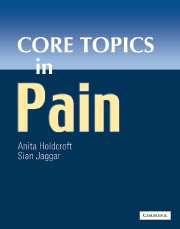Book contents
- Frontmatter
- Contents
- Contributors
- Preface
- Acknowledgements
- Foreword
- General abbreviations
- Basic science abbreviations
- PART 1 BASIC SCIENCE
- 1 Overview of pain pathways
- 2 Peripheral mechanisms
- 3 Central mechanisms
- 4 Pharmacogenomics and pain
- 5 Peripheral and central sensitization
- 6 Inflammation and pain
- 7 Nerve damage and its relationship to neuropathic pain
- 8 Receptor mechanisms
- PART 2 PAIN ASSESSMENT
- Section 2a Pain measurement
- Section 2b Diagnostic strategies
- PART 3 PAIN IN THE CLINICAL SETTING
- Section 3a Clinical presentations
- Section 3b Pain syndromes
- PART 4 THE ROLE OF EVIDENCE IN PAIN MANAGEMENT
- PART 5 TREATMENT OF PAIN
- Section 5a General Principles
- Section 5b Physical treatments
- Section 5c Pharmacology
- Section 5d Psychosocial
- PART 6 SUMMARIES
- Glossary
- Index
3 - Central mechanisms
from PART 1 - BASIC SCIENCE
Published online by Cambridge University Press: 10 December 2009
- Frontmatter
- Contents
- Contributors
- Preface
- Acknowledgements
- Foreword
- General abbreviations
- Basic science abbreviations
- PART 1 BASIC SCIENCE
- 1 Overview of pain pathways
- 2 Peripheral mechanisms
- 3 Central mechanisms
- 4 Pharmacogenomics and pain
- 5 Peripheral and central sensitization
- 6 Inflammation and pain
- 7 Nerve damage and its relationship to neuropathic pain
- 8 Receptor mechanisms
- PART 2 PAIN ASSESSMENT
- Section 2a Pain measurement
- Section 2b Diagnostic strategies
- PART 3 PAIN IN THE CLINICAL SETTING
- Section 3a Clinical presentations
- Section 3b Pain syndromes
- PART 4 THE ROLE OF EVIDENCE IN PAIN MANAGEMENT
- PART 5 TREATMENT OF PAIN
- Section 5a General Principles
- Section 5b Physical treatments
- Section 5c Pharmacology
- Section 5d Psychosocial
- PART 6 SUMMARIES
- Glossary
- Index
Summary
The essential message of this chapter is that pain is a perception subject to all the vagaries and trickery of our conscious mind. There is no simple relationship between a given noxious stimulus and the perception of pain. This was first highlighted by Melzack and Wall who reported that traumatic injuries sustained during athletic competitions or combat, were often initially described as being relatively painless. Psychological factors, such as arousal, attention and expectation can influence central nervous system (CNS) circuits involved in pain modulation.
Pain transmission depends on the balance of inhibitory and facilitatory influences acting on the neural circuits of the somatosensory system. Integration of these influences occurs at multiple levels of the CNS including the spinal cord, brain stem and multiple cortical regions. This chapter will elucidate some of these complex influences on central pain transmission. Derangements in these systems are often critical in the generation and maintenance of chronic pain. Some of the oldest (e.g. opioids) as well as the newest (e.g. gamma amino butyric acid (GABA) pentin) analgesics access these control mechanisms.
Modulation of pain processing at the level of the spinal cord
The dorsal horn (DH) of the spinal cord is an important area for integration of multiple inputs, including primary (1°) sensory neurones and local interneurone networks, as well as descending control from supra-spinal centres.
- Type
- Chapter
- Information
- Core Topics in Pain , pp. 17 - 22Publisher: Cambridge University PressPrint publication year: 2005



